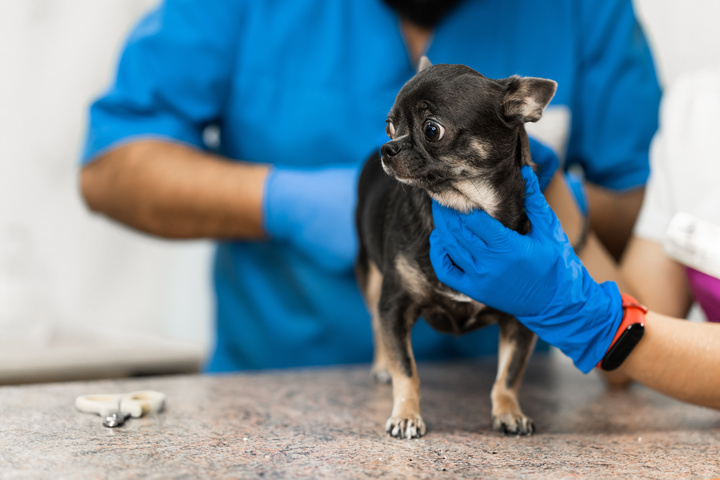Taking care of your furry friend’s overall health and well-being is essential. This includes their backside. You may not know this, but your pup has two small glands situated at approximately the 4 and 8 o’clock positions on either side of the anus. These glands feel like small, pea-sized sacs under the skin and are called anal glands or anal sacs.
If these sacs become impacted or blocked, they can lead to discomfort and pain for your furry friend. Knowing the signs of impacted anal glands is important so that you can help relieve your pup as quickly as possible.
What are anal glands?
Anal glands, also known as anal sacs, are basically scent glands that release an oily substance that is quite unpleasant – almost fishly-like – to us humans. However, the odor is not offensive to dogs.
Have you ever noticed that when dogs meet each other, they tend to immediately start sniffing around each other’s rear parts? This is because the anal sacs release a scent that contains vital information about the hormonal status of a dog. The secretions contain a unique scent that is specific to each individual dog.
When a dog poops, it secretes some substances that are left behind with the feces. This leaves a mark and communicates information about the dog to other canines in the area. By sniffing the scent left by other dogs, canines gather information about the individual who left the mark. They can determine the dog’s sex, reproductive status, and possibly even their health condition.
Dogs use the scent from their anal sacs to communicate social cues, establish dominance, and convey information about their status, intentions, and territory boundaries within their pack or social group.
What is anal gland impaction?
If anal glands are not regularly emptied, they can become clogged or impacted, preventing the secretion of the oily, semi-solid substance inside. This can cause pain, inflammation, and even infection.
Dogs usually release their anal glands during a bowel movement, but sometimes the stool is not firm enough to initiate this process. Some breeds are more susceptible to impaction and require assistance to release them. Small breeds, such as Chihuahuas, Lhasa Apsos, Basset Hounds, Beagles, and Cocker Spaniels, are often affected by anal gland impaction.
Signs my dog’s anal glands are impacted
If your dog is suffering from anal gland impaction, you may notice a number of signs including.
Excessive licking or butt scooting. Dogs with impacted anal glands often lick or bite around their anus frequently or may scoot their rear end along the ground.
Foul odor. You might notice a strong, unpleasant odor emanating from your dog’s rear end. This odor is typically distinct and may smell fishy or foul.
Discomfort or pain. Your furry friend may show signs of discomfort or pain when sitting down, defecating, or being touched around the anal area.
Swelling or redness. The area surrounding the opening of the rectum, commonly known as the anus, may display signs of inflammation, such as swelling, redness, or irritation
Visible discharge. You might observe a dense, yellow-brown liquid oozing out of the anal glands. This fluid may also be accompanied by blood if the glands are excessively clogged or inflamed.
Changes in behavior. Your canine companion may exhibit changes in behavior, such as restlessness, irritability, or reluctance to eat due to discomfort.
The best diet for anal gland health
Ensuring your furry friend is on a high-quality diet can aid in regular elimination and produce a well-formed stool. A well-formed, firm stool applies just the right amount of pressure to the anal sacs as it passes over the glands. This pressure causes the glands to express.
Dogs require food that contains an ample amount of moisture and soluble fiber not found in kibble. A diet that contains high moisture levels also assists in preventing the anal discharge from becoming dense and difficult to excrete.
Adding a little ground pumpkin or psyllium husk will add bulk to the stool. Many who feed their fur babies raw food add ground bone for well-formed stools that appear chalky white as they dry.
Self Expression – How to do it when necessary
For pet parents with breeds that need frequent anal gland expression, a quick visit to the vet or even a groomer can do the trick. If you need to express the glands yourself, here’s how to do it.
It is important to choose a space where cleaning up any mess is easy. Some people prefer to express their dog’s glands during bath time. You should have paper towels, gloves, and a mild disinfectant handy. Having someone assist you in holding your dog steady if needed is also a good idea.
Position your dog in a comfortable spot, such as standing with its rear end facing away from you or lying on its side. Wear disposable gloves to protect your hands from gland secretions and bacteria.
Gently lift your dog’s tail and apply gentle pressure to the glands with your thumb and forefinger. Use a tissue or paper towel to catch the fluid as it’s expelled. Be careful not to squeeze too hard or apply excessive pressure, which can cause discomfort or injury.
After expressing the glands, clean the area around the anus with a mild disinfectant to remove any remaining residue and prevent infection. Be sure to keep an eye on your dog for any signs of discomfort, bleeding, or infection. If you notice any abnormalities, consult your veterinarian promptly.






